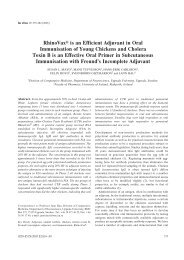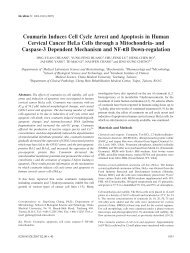Leukocyte and Endothelial Cell Adhesion Molecules in Inflammation ...
Leukocyte and Endothelial Cell Adhesion Molecules in Inflammation ...
Leukocyte and Endothelial Cell Adhesion Molecules in Inflammation ...
Create successful ePaper yourself
Turn your PDF publications into a flip-book with our unique Google optimized e-Paper software.
Golias et al: <strong>Adhesion</strong> <strong>Molecules</strong> <strong>in</strong> Inflammatory Heart Disease (Review)<br />
Figure 2. Structure of some immunoglobul<strong>in</strong> gene superfamily members.<br />
ICAM-3 is constitutively expressed at high levels by all<br />
rest<strong>in</strong>g leukocytes, such as monocytes, lymphocytes <strong>and</strong><br />
neutrophils, as well as antigen-present<strong>in</strong>g cells, show<strong>in</strong>g a<br />
pattern of expression clearly dist<strong>in</strong>ct from that of ICAM-1<br />
<strong>and</strong> ICAM-2 (52). Dur<strong>in</strong>g the latent status of T-cells the<br />
ICAM-3 is considered the lig<strong>and</strong> for LFA-1. It is possible that<br />
ICAM-3 has a very important role <strong>in</strong> the activation cascade of<br />
the immunological response, cellular adhesion <strong>and</strong> signal<br />
transduction if we take <strong>in</strong>to account the fact that it causes<br />
<strong>in</strong>creased adhesion through the ‚1- <strong>and</strong> ‚2-<strong>in</strong>tegr<strong>in</strong> pathways<br />
(53, 47). Additionally, it has been postulated that ICAM-3 is<br />
related to lymphomas <strong>and</strong> myelomas consider<strong>in</strong>g that the<br />
vascular endothelium <strong>in</strong> such conditions secretes <strong>in</strong>creased<br />
amounts of ICAM-3 (54, 55).VCAM-1, which exhibits low to<br />
negligible expression on unstimulated endothelial cells, can<br />
be profoundly up-regulated after cytok<strong>in</strong>e challenge. This<br />
molecule is expressed on the surface of activated<br />
endothelium <strong>and</strong> a variety of other cell types <strong>in</strong>clud<strong>in</strong>g bone<br />
marrow fibroblasts, tissue macrophages <strong>and</strong> dendritic cells. It<br />
can be up-regulated by <strong>in</strong>flammatory mediators such as<br />
<strong>in</strong>terleuk<strong>in</strong>1‚ (IL-1‚), IL-4, CD44, TNF· <strong>and</strong> IFN-Á.<br />
PECAM-1, also known as CD31 or endoCAM, is<br />
constitutively expressed on platelets, monocytes <strong>and</strong><br />
neutrophils, <strong>and</strong> <strong>in</strong> large amounts on endothelial cells at<br />
<strong>in</strong>tercellular junctions <strong>and</strong> on T-cell subsets (56-58).<br />
PECAM-1 can mediate adhesion through either homophilic<br />
or heterophilic <strong>in</strong>teractions (59). It is produced by platelets,<br />
monocytes <strong>and</strong> neutrophils <strong>in</strong> lower doses (57, 58). PECAM-<br />
1 is highly implicated <strong>in</strong> the migration of leukocytes through<br />
the vascular endothelium via <strong>in</strong>tercellular junctions (57).<br />
Furthermore, it is implicated <strong>in</strong> the cross reactions of CD8 +<br />
<strong>and</strong> T-cells with <strong>in</strong>tercellular adhesion site molecules via the<br />
<strong>in</strong>tegr<strong>in</strong> adhesion process (39).<br />
The mucosal address<strong>in</strong> MAdCAM-1 is found on high<br />
endothelial venules (HEV) <strong>and</strong> ma<strong>in</strong>ly expressed on HEVs<br />
of Peyer's patches, on venules <strong>in</strong> small <strong>in</strong>test<strong>in</strong>al lam<strong>in</strong>a<br />
propria, on the marg<strong>in</strong>al s<strong>in</strong>us of the spleen, <strong>and</strong> on HEVs<br />
of embryonic lymph nodes (60). It is <strong>in</strong>volved <strong>in</strong> tissuespecific<br />
hom<strong>in</strong>g of lymphocytes <strong>in</strong> lymph nodes <strong>and</strong> mucosal<br />
lymphoid tissues (8, 61).<br />
CD44. The CD44 prote<strong>in</strong>s belong to a highly heterogenous<br />
family of hyaluronan-b<strong>in</strong>d<strong>in</strong>g type I transmembrane<br />
glycoprote<strong>in</strong>s, <strong>in</strong>volved <strong>in</strong> cell-cell <strong>and</strong> cell-matrix<br />
<strong>in</strong>teractions. This family of transmembrane glycoprote<strong>in</strong>s is<br />
identified as a large number of isoforms with a common<br />
stable molecular part. The ma<strong>in</strong> structure of the CD44<br />
molecule consists of an N-term<strong>in</strong>al extracellular doma<strong>in</strong>, a<br />
membrane proximal region, a transmembrane doma<strong>in</strong> <strong>and</strong><br />
a cytoplasmic tail (Figure 3) (17, 62). The extracellular<br />
doma<strong>in</strong> of the st<strong>and</strong>ard form consists of a 270 am<strong>in</strong>o acid<br />
cha<strong>in</strong>, folded <strong>in</strong>to a globular tertiary structure by disulphide<br />
bonds between three pairs of cyste<strong>in</strong>e residues on its<br />
761






